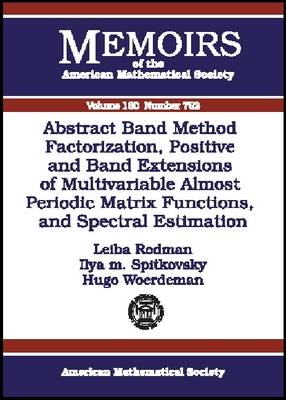Memoirs of the American Mathematical Society
2 total works
Model Theory and Linear Extreme Points in the Numerical Radius Unit Ball
by Michael A Dritschel and Hugo J. Woerdeman
Published 1 January 1997
This memoir initiates a model theory-based study of the numerical radius norm. Guided by the abstract model theory of Jim Agler, the authors propose a decomposition for operators that is particularly useful in understanding their properties with respect to the numerical radius norm. Of the topics amenable to investigation with these tools, the following are presented: a complete description of the linear extreme points of the $n\times n$ matrix (numerical radius) unit ball; several equivalent characterizations of matricial extremals in the unit ball; that is, those members which do not allow a nontrivial extension remaining in the unit ball; and, applications to numerical ranges of matrices, including a complete parameterization of all matrices whose numerical ranges are closed disks.In addition, an explicit construction for unitary 2-dilations of unit ball members is given, Ando's characterization of the unit ball is further developed, and a study of operators satisfying $ A - \textnormal {Re} (e^{i\theta}A)\geq 0$ for all $\theta$ is initiated.
New versions are developed of an abstract scheme, which are designed to provide a framework for solving a variety of extension problems. The abstract scheme is commonly known as the band method. The main feature of the new versions is that they express directly the conditions for existence of positive band extensions in terms of abstract factorizations (with certain additional properties). The results allow us to prove, among other things, that the band extension is continuous in an appropriate sense. Using the new versions of the abstract band method, we solve the positive extension problem for almost periodic matrix functions of several real variables with Fourier coefficients indexed in a given additive subgroup of the space of variables.This generality allows us to treat simultaneously many particular cases, for example the case of functions periodic in some variables and almost periodic in others. Necessary and sufficient conditions are given for the existence of positive extensions in terms of Toeplitz operators on Besikovitch spaces. Furthermore, when a solution exists a special extension (the band extension) is constructed which enjoys a maximum entropy property.A linear fractional parameterization of the set of all extensions is also provided. We interpret the obtained results (in the periodic case) in terms of existence of a multivariate autoregressive moving averages (ARMA) process with given autocorrelation coefficients, and identify its maximal prediction error. Another application concerns the solution of the positive extension problem in the context of Wiener algebra of infinite operator matrices. It includes the identification of the maximum entropy extension and a description of all positive extensions via a linear fractional formula. In the periodic case it solves a linear estimation problem for cyclostationary stochastic processes.

